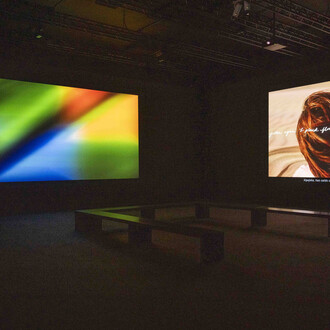Grants for Video Art Creation, which promote audiovisual artistic production Spain and its dissemination through different public programmes.
As part of this joint project to support contemporary art, the museum is hosting the presentation of several of the works resulting from the grants awarded in the 2018 edition, most of them premieres. The exhibition programme includes works by Antoni Abad, Toni Serra (Abu Ali), Mabel Palacín, Nadia Hotait, Manu Arregui and Pedro G. Romero, artists from different generations with a variety of orientations who use the moving image as a tool for creation and inquiry, thus offering an examination to video today.
Now on view. Pedro G. Romero. Las flamencas / Los flamencos. Intermittent rehearsal, 2019–2021. 49 min (nine sequences of 5 min. 9 sec.)
Pedro G. Romero, National Fine Arts Award winner in 2024, is premiering the installation Las flamencas / Los flamencos in Bilbao. It was produced thanks to a Fundación BBVA-Bilbao Fine Arts Museum Multiverse Video Art Creation Grant (2018).
The video creation is comprised of nine strolls featuring nine personalities associated with the world of flamenco, with the city of Seville as the backdrop. All nine walk through different spaces in a psychological-geographic, visual and sound exploration that talks about flamenco as a particular way of life. As a kind of video-essay, these portraits unfold simultaneously before the spectator as they walk among them near sounds and images, almost as if they were on the street.
The different material circumstances generating this piece are associated with the production of the film Nueve Sevillas [Nine Sevilles], which was shot in 2018 under the direction of Gonzalo García Pelayo (Madrid, 1947). This flamenco film about Seville and the many ways the city imagines itself sprang from a series of strolls or meanders that Pedro G. Romero took around the city with the same nine personalities portrayed in these videos.
The project’s earlier titles, Las sabias [The wise women] and Las sabiondas y los sabiondos [The know-it-all women and men], spoke about how the characters know the city just by breathing. But all this knowledge was absorbed by the film Nueve Sevillas. And yet, there was something essential, basic, sensorial and mute—if you will—that was not in that film.
Somehow the psycho-geographic essence of the project was lost in favour of other narrative, musical, poetic and political elements. The fact is that there is an intermittent, insincere stroll underlying the film: the experience of walking around Seville infinite times, the many Sevilles that there are in Seville. And that drifting, its immediate expression, is the crux, the direction where Las flamencas / Los flamencos is pointing. After all, the experience of flamenco is also an experience of Seville—among other things, the city where Pedro G. Romero’s studio is located.
Las flamencas / Los flamencos essentially examines the nine mute strolls that the characters in Nueve Sevillas took around the city. The intermittency of the images reflects that idea of the ‘deafening silence’ of everything heard around the images. There are nine walks, one by each person in the story, lasting 49 minutes, divided into identical sequences of 5 minutes 9 seconds each, in which the interaction of the sound changes with different images, different walks, different videos. It is a route whose sound marks the other features of each stroll.
The piece unfolds on nine monitors placed in a row, like an amphitheatre or a labyrinth—as it may be—and the spectator has to go through the exhibition visiting, listening to and seeing each monitor, thanks to the combination of monitors and sounds. Seeing the entire piece thus means walking through them. Making the walk necessary for the spectators to see the entire piece is crucial as they draw closer to and further from each of the monitors. Las flamencas / Los flamencos is also a walking piece, as well as the distillation, essence and power of Nueve Sevillas. It offers an experience of walking from one projection to another. Showing it necessarily contains the museum space as a place for a kind of wandering. Attention will always be intermittent.
The 49 minutes are filled with all types of sensorial details that go beyond just the images themselves. The birds singing in the museum square, Javiera de la Fuente intoning Violeta Parra’s Qué he ganado con quererte, the sounds of Errico Petrella’s Ione performed by a processional band, the song Pájaro negro/Auschwitz’s song/Samudaripen sung by Janek and the deafening clapping of Bobote, Marco de Ana, Diaa Homsy, Sonia Poveda and Lole de los Reyes, which make the credits tremble… these are just some of the encounters scattered through the walk through the museum. While Charles Baudelaire coined the word flâneur, in Cádiz the cantaor Enrique el Mellizo was famous for his strolls—some said philosophical, some said poetic—whose unique feature was silence: El Mellizo always walked in silence.
Thus, while we like to distinguish between walks, meanders or hikes, the public is essentially invited to spend sometime here in the streets of Seville walking whatever way they want.
















